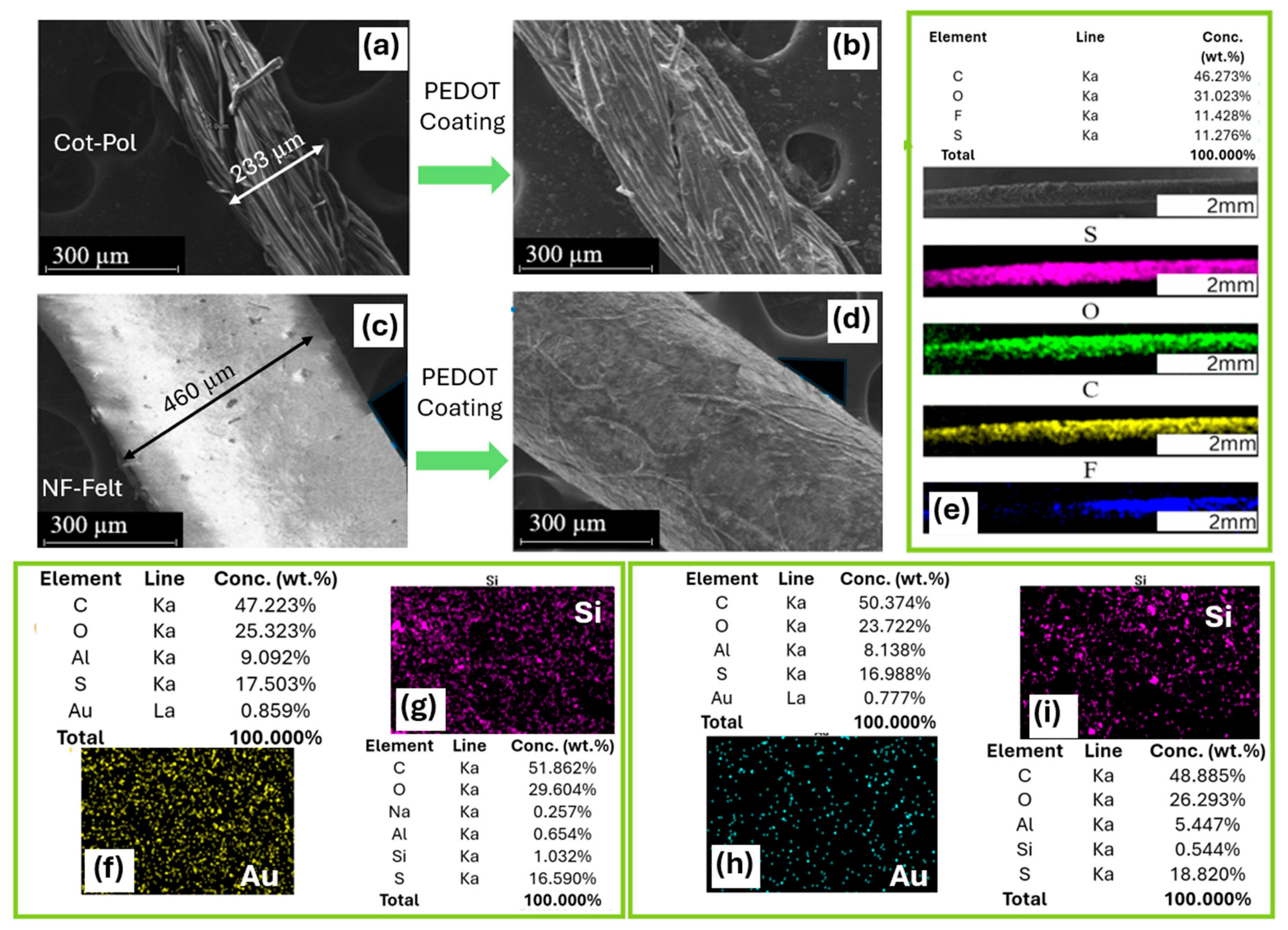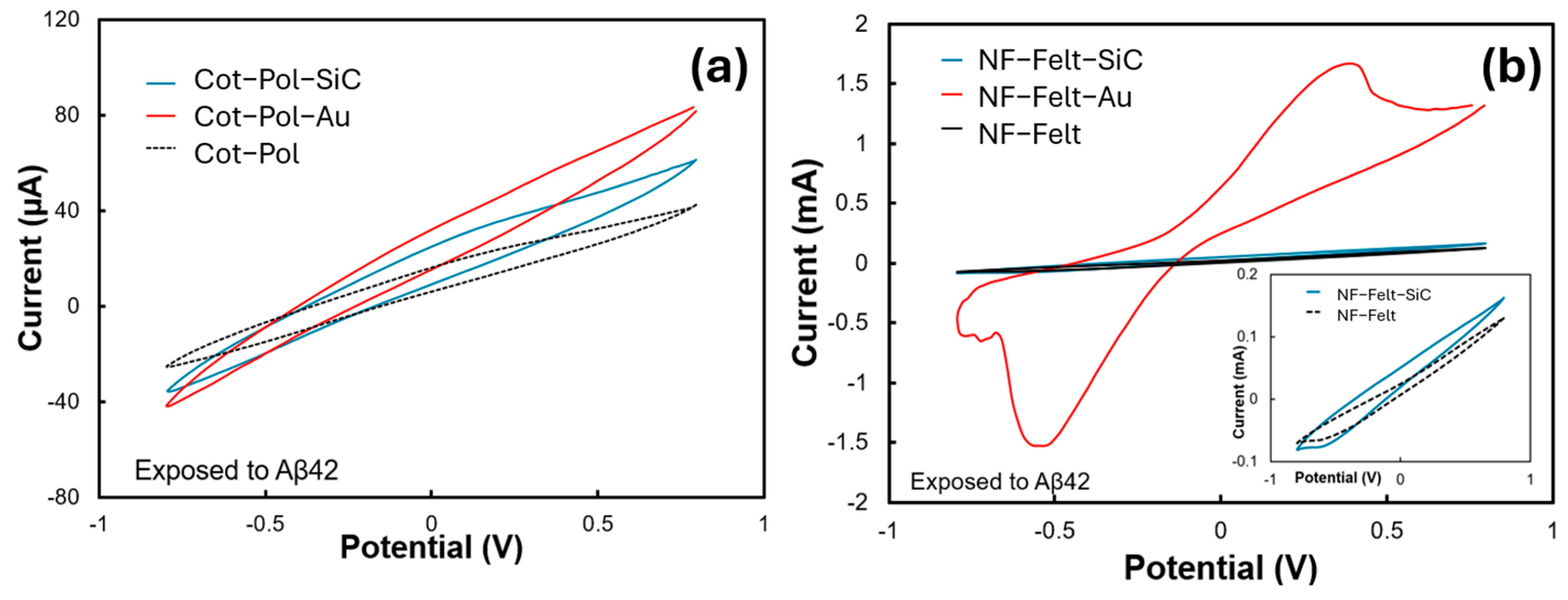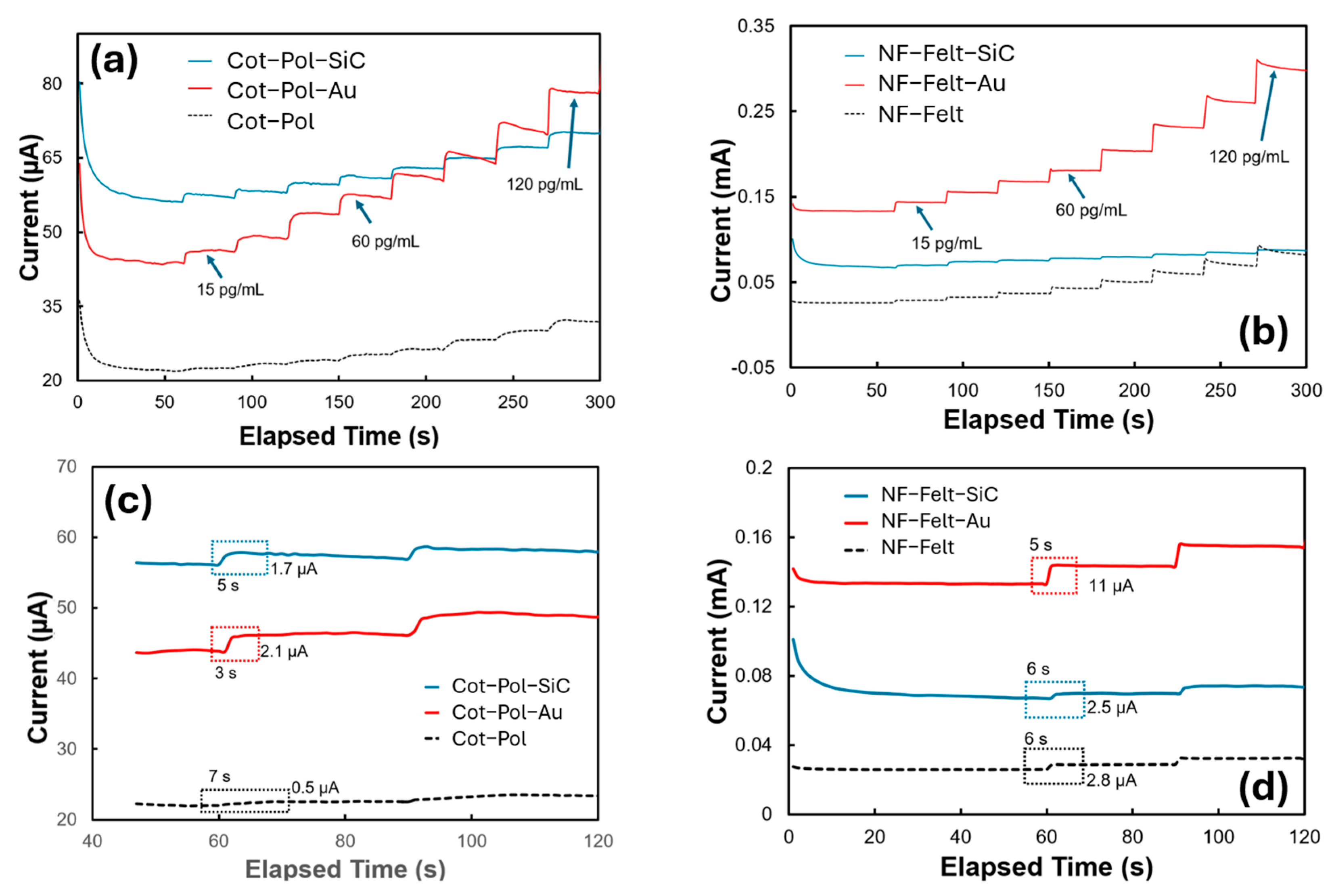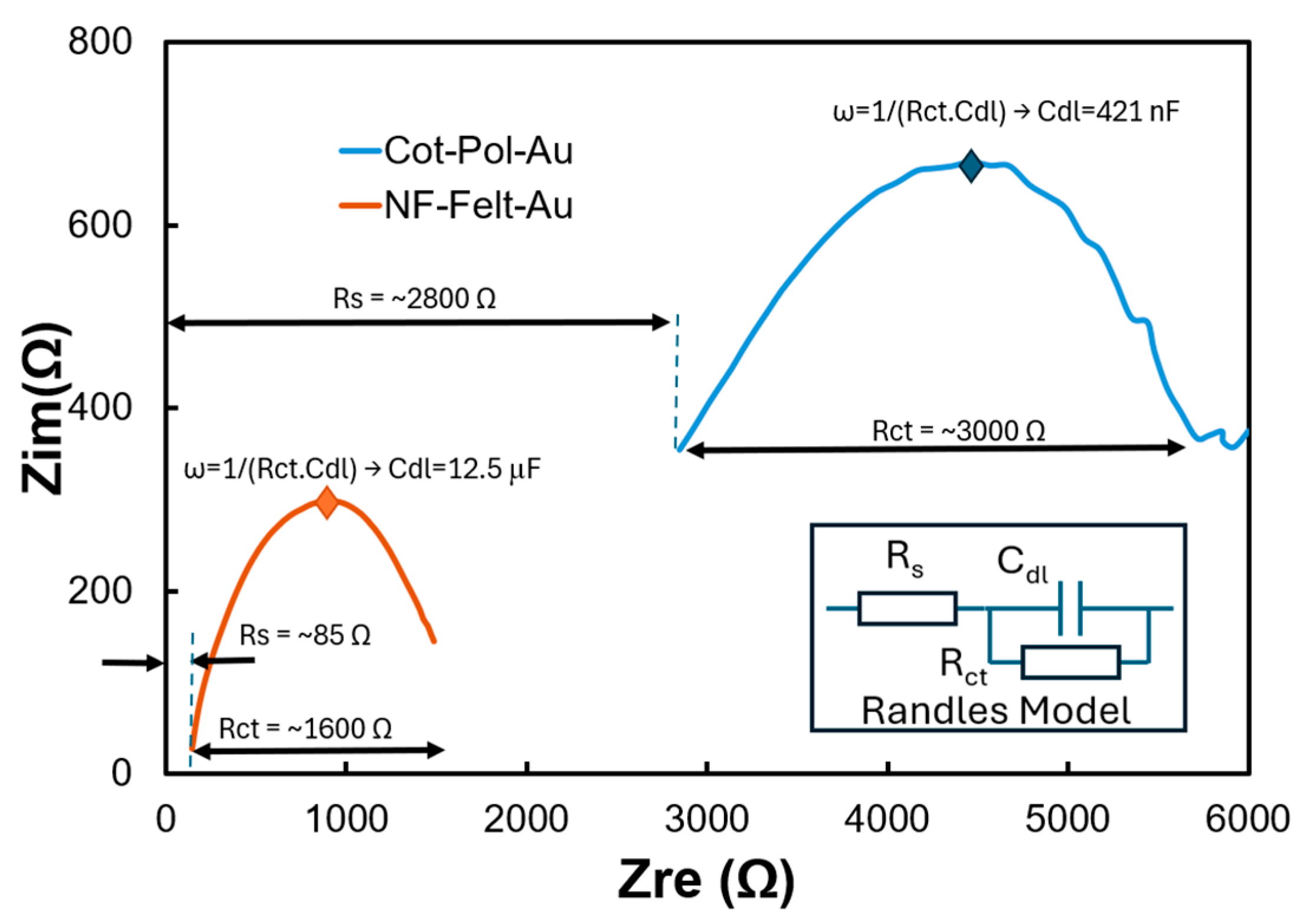String-Shaped Electrodes for Aβ42 Detection Towards Early Diagnosis of Alzheimer’s Disease
Abstract
1. Introduction
2. Materials and Methods
2.1. Materials and Equipment
2.2. Fabrication Process of the String-Shaped Electrodes
2.2.1. Fabrication Process of Nanofiber-Felt (NF-Felt) Strings
2.2.2. PEDOT:PSS Coating
2.2.3. Electrode Fabrications
3. Results and Discussion
4. Conclusions
Supplementary Materials
Author Contributions
Funding
Institutional Review Board Statement
Informed Consent Statement
Data Availability Statement
Acknowledgments
Conflicts of Interest
Abbreviations
| AD | Alzheimer’s disease |
| Aβ42 | Amyloid-Beta 42 |
| NPs | Nanoparticles |
| ITO | Indium-tin-oxide |
| NF-Felt | Nanofiber-felt |
| PBS | Phosphate-buffer solution |
| MPA | 3-Mercaptopropionic acid |
| EDC | N-(3- Dimethylaminopropyl)-N-ethylcarbodiimide hydrochloride |
| NHS | N-hydroxysuccinimide |
| DMSO | Dimethyl sulfoxide DMSO |
| PEDOT:PSS | Poly(2,3-dihydrothieno-1,4-dioxin)-poly(styrenesulfonate) |
| DMF | N,N-dimethylformamide |
| DBSA | Dodecylben-zenesulfonic acid |
| EG | Ethylene glycol |
| PVDF-HFP | Polyvinylidene fluoride-co-hexafluoropropylene |
| SEM | Scanning electron microscope |
| CV | Cyclic voltammetry |
| EIS | Electrochemical impedance spectroscopy |
| CA | Chronoamperometry |
| EDS | Energy-dispersive X-ray spectroscopy |
| Cot-Pol | 25% cotton-75% polyester |
| SAM | Self-assembled monolayer |
References
- Long, J.M.; Holtzman, D.M. Alzheimer Disease: An Update on Pathobiology and Treatment Strategies. Cell 2019, 179, 312–339. [Google Scholar] [CrossRef] [PubMed]
- Rasmussen, J.; Langerman, H. Alzheimer’s Disease—Why We Need Early Diagnosis. Degener. Neurol. Neuromuscul. Dis. 2019, 9, 123–130. [Google Scholar] [CrossRef] [PubMed]
- Yada, Y.; Naoki, H. Few-shot prediction of amyloid beta accumulation from mainly unpaired data on biomarker candidates. NPJ Syst. Biol. Appl. 2023, 9, 59. [Google Scholar] [CrossRef] [PubMed]
- Nakamura, A.; Kaneko, N.; Villemagne, V.L.; Kato, T.; Doecke, J.; Dore, V.; Fowler, C.; Li, Q.X.; Martins, R.; Rowe, C.; et al. High performance plasma amyloid-beta biomarkers for Alzheimer’s disease. Nature 2018, 554, 249–254. [Google Scholar] [CrossRef] [PubMed]
- Zurcher, C.; Humpel, C. Saliva: A challenging human fluid to diagnose brain disorders with a focus on Alzheimer’s disease. Neural Regen. Res. 2023, 18, 2606–2610. [Google Scholar] [CrossRef] [PubMed]
- Sabbagh, M.N.; Shi, J.; Lee, M.; Arnold, L.; Al-Hasan, Y.; Heim, J.; McGeer, P. Salivary beta amyloid protein levels are detectable and differentiate patients with Alzheimer’s disease dementia from normal controls: Preliminary findings. BMC Neurol. 2018, 18, 155. [Google Scholar] [CrossRef] [PubMed]
- Chen, H.; Xiao, M.; He, J.; Zhang, Y.; Liang, Y.; Liu, H.; Zhang, Z. Aptamer-functionalized carbon nanotube field-effect transistor biosensors for Alzheimer’s disease serum biomarker detection. ACS Sens. 2022, 7, 2075–2083. [Google Scholar] [CrossRef] [PubMed]
- Kemiklioglu, E.; Tuncgovde, E.B.; Ozsarlak-Sozer, G. Development of liquid crystal biosensor for the detection of amyloid beta-42 levels associated with Alzheimer’s disease. J. Biosci. Bioeng. 2021, 132, 88–94. [Google Scholar] [CrossRef] [PubMed]
- Hsu, C.-H.; Gupta, A.K.; Purwidyantri, A.; Prabowo, B.A.; Chen, C.-H.; Chuang, C.-C.; Tian, Y.-C.; Lu, Y.-J.; Lai, C.-S. Sensing alzheimer’s disease utilizing au electrode by controlling nanorestructuring. Chemosensors 2022, 10, 94. [Google Scholar] [CrossRef]
- Han, J.; Zhang, M.; Chen, G.; Zhang, Y.; Wei, Q.; Zhuo, Y.; Xie, G.; Yuan, R.; Chen, S. Ferrocene covalently confined in porous MOF as signal tag for highly sensitive electrochemical immunoassay of amyloid-β. J. Mater. Chem. B 2017, 5, 8330–8336. [Google Scholar] [CrossRef] [PubMed]
- Carneiro, P.; Loureiro, J.; Delerue-Matos, C.; Morais, S.; do Carmo Pereira, M. Alzheimer’s disease: Development of a sensitive label-free electrochemical immunosensor for detection of amyloid beta peptide. Sens. Actuators B Chem. 2017, 239, 157–165. [Google Scholar] [CrossRef]
- Le, H.; Park, J.; Cho, S. A probeless capacitive biosensor for direct detection of amyloid beta 1–42 in human serum based on an interdigitated chain-shaped electrode. Micromachines 2020, 11, 791. [Google Scholar] [CrossRef] [PubMed]
- Kecili, R.; Hussain, C.M. Mechanism of Adsorption on Nanomaterials. In Nanomaterials in Chromatography; Elsevier: Amsterdam, The Netherlands, 2018; pp. 89–115. [Google Scholar]
- Azimzadeh, M.; Nasirizadeh, N.; Rahaie, M.; Naderi-Manesh, H. Early detection of Alzheimer’s disease using a biosensor based on electrochemically-reduced graphene oxide and gold nanowires for the quantification of serum microRNA-137. RSC Adv. 2017, 7, 55709–55719. [Google Scholar] [CrossRef]
- Sun, L.; Zhong, Y.; Gui, J.; Wang, X.; Zhuang, X.; Weng, J. A hydrogel biosensor for high selective and sensitive detection of amyloid-beta oligomers. Int. J. Nanomed. 2018, 13, 843–856. [Google Scholar] [CrossRef] [PubMed]
- Liu, Z.; Yan, Z.; Jia, L.; Song, P.; Mei, L.; Bai, L.; Liu, Y. Gold nanoparticle decorated electrospun nanofibers: A 3D reproducible and sensitive SERS substrate. Appl. Surf. Sci. 2017, 403, 29–34. [Google Scholar] [CrossRef]
- Tavakkoli, N.; Soltani, N.; Tabar, Z.K.; Jalali, M.R. Determination of dopamine using the indium tin oxide electrode modified with direct electrodeposition of gold–platinum nanoparticles. Chem. Pap. 2019, 73, 1377–1388. [Google Scholar] [CrossRef]
- Montero-Arevalo, B.; Seufert, B.I.; Hossain, M.S.; Bernardin, E.; Takshi, A.; Saddow, S.E.; Schettini, N. SiC electrochemical sensor validation for Alzheimer Aβ42 antigen detection. Micromachines 2023, 14, 1262. [Google Scholar] [CrossRef] [PubMed]
- Seufert, B.; Thomas, S.; Takshi, A. Stretchable Nanofiber-Based Felt as a String Electrode for Potential Use in Wearable Glucose Biosensors. Sensors 2024, 24, 1283. [Google Scholar] [CrossRef] [PubMed]
- Dai, Y.; Molazemhosseini, A.; Liu, C.C. In vitro quantified determination of β-amyloid 42 peptides, a biomarker of neuro-degenerative disorders, in PBS and human serum using a simple, cost-effective thin gold film biosensor. Biosensors 2017, 7, 29. [Google Scholar] [CrossRef] [PubMed]
- Rios, N.O.M.; Takshi, A. Stability of fiber-based organic electrochemical transistors with a gel electrolyte for wearable electronics. In Organic and Hybrid Sensors and Bioelectronics XV; SPIE: Bellingham, WA, USA, 2022; pp. 16–21. [Google Scholar]
- Zhang, Y.; Ren, B.; Zhang, D.; Liu, Y.; Zhang, M.; Zhao, C.; Zheng, J. Design principles and fundamental understanding of biosensors for amyloid-β detection. J. Mater. Chem. B 2020, 8, 6179–6196. [Google Scholar] [CrossRef] [PubMed]






| Reference | Sensing Electrode | Limit of Detection | Detection Range |
|---|---|---|---|
| [11] | Planar Gold Electrode | 5.2 pg/mL | 10–1000 pg/mL |
| [9] | Planar Gold Electrode | 10.4 fg/mL | 0.1–106 pg/mL |
| [12] | Interdigitated Electrode | 7.5 pg/mL | 10–104 pg/mL |
| [10] | Glassy Carbon Electrode | 0.03 pg/mL | 10−3–100 ng/mL |
| [14] | rGO with Au nanowires | 7.6 pg/mL | 22–3400 pg/mL |
| This work: Cot-Pol-Au | Cot-Pol String/PEDOT:PSS/Au NPs | 12.85 pg/mL | 15–120 pg/mL |
| This work: NF-Felt-Au | PVDF-NFs/PEDOT:PSS/Au NPs | 8.36 pg/mL | 15–120 pg/mL |
Disclaimer/Publisher’s Note: The statements, opinions and data contained in all publications are solely those of the individual author(s) and contributor(s) and not of MDPI and/or the editor(s). MDPI and/or the editor(s) disclaim responsibility for any injury to people or property resulting from any ideas, methods, instructions or products referred to in the content. |
© 2025 by the authors. Licensee MDPI, Basel, Switzerland. This article is an open access article distributed under the terms and conditions of the Creative Commons Attribution (CC BY) license (https://creativecommons.org/licenses/by/4.0/).
Share and Cite
Seufert, B.; Thomas, S.; Takshi, A. String-Shaped Electrodes for Aβ42 Detection Towards Early Diagnosis of Alzheimer’s Disease. Chemosensors 2025, 13, 199. https://doi.org/10.3390/chemosensors13060199
Seufert B, Thomas S, Takshi A. String-Shaped Electrodes for Aβ42 Detection Towards Early Diagnosis of Alzheimer’s Disease. Chemosensors. 2025; 13(6):199. https://doi.org/10.3390/chemosensors13060199
Chicago/Turabian StyleSeufert, Bianca, Sylvia Thomas, and Arash Takshi. 2025. "String-Shaped Electrodes for Aβ42 Detection Towards Early Diagnosis of Alzheimer’s Disease" Chemosensors 13, no. 6: 199. https://doi.org/10.3390/chemosensors13060199
APA StyleSeufert, B., Thomas, S., & Takshi, A. (2025). String-Shaped Electrodes for Aβ42 Detection Towards Early Diagnosis of Alzheimer’s Disease. Chemosensors, 13(6), 199. https://doi.org/10.3390/chemosensors13060199





